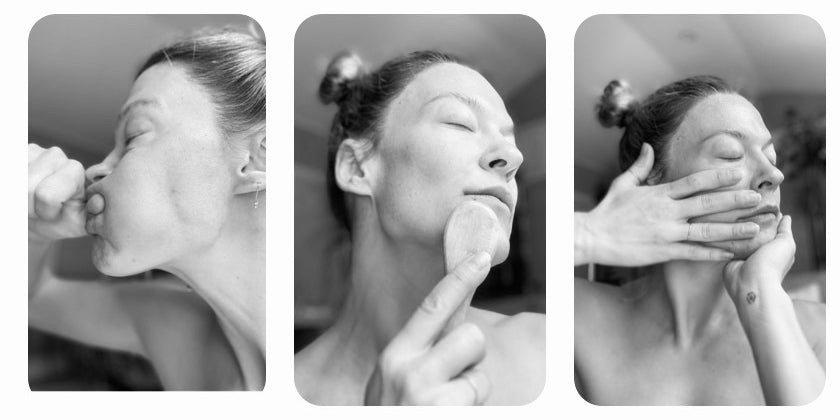Get Glowing, Fabulous, & Healthier Skin: The Role of Facial Fascia

Key Takeaways:
- By taking care of your facial fascia, you can achieve healthier skin and get a younger-looking face.
- Maintaining healthy fascia helps you avoid a tired appearance, reduces dark circles, and minimizes puffiness.
- From dry brushing and using tissue manipulation tools to incorporating manual techniques, there are many effective strategies for activating your facial fascia and getting great skin.
What Is Facial Fascia?
When it comes to maintaining youthful, fabulous skin, we often turn to skincare products and treatments. But have you ever considered the role of your facial fascia?
At its core, the facial fascia is a connective tissue that wraps around your muscles, blood vessels, and nerves in your face. (I want to highlight that fascia is in your entire body, but in this blog, I'll keep the focus on facial fascia and achieving great skin.) When stressed, it tightens up, leading to poor blood circulation and changes in the overall structure of your face. That's why it's important to take care of your facial fascia to get healthier and clearer skin.
3 Things That Healthy Facial Fascia Can Do for Your Skin
Are you tired of hearing people asking you if everything is all right because of your dark circles? Then keep reading!
Fascia plays a role in lymphatic drainage, which helps remove toxins and excess fluids from the skin. But if it's tight or unhealthy, this drainage can be compromised, resulting in puffiness and dark circles. By keeping your fascia active, you can reduce swelling, maintain skin tone, and achieve a fresh appearance.
Added to that, healthy fascia promotes better blood circulation to your skin, which helps deliver oxygen and nutrients. This keeps your skin vibrant and glowing and delays the visible signs of aging. With good blood flow, your skin can also quickly recover from minor injuries. As a result, you can experience fewer blemishes and a smoother face.
Wondering why your cheeks seem to be losing their lift? Or feeling like your once-sharp jawline is starting to soften? This happens because, with age, muscles and fat lose volume can cause the skin to droop. When the fascia is healthy, it maintains the position of the muscles, preventing them from shifting and contributing to a more defined and sculpted appearance.
The Difference Between Superficial and Deep Facial Fascia
Imagine your face as having two layers of wrapping paper. The superficial fascia is the top layer—thin and closer to your skin. It holds things like fat and connects your skin to the muscles underneath. This layer is flexible and moves when you make facial expressions.
The deep fascia, on the other hand, is the second layer. It's tougher and wraps around the muscles, nerves, and blood vessels more tightly. This layer provides support and structure, keeping everything in place beneath the skin.
Therefore, it's important to take care of both superficial and deep fascia to achieve clearer skin.
Techniques To Treat Your Fascia and Get a Younger-Looking Face
Slowing down the signs of an aging neck
When it comes to skincare, many of us focus solely on our face. But here's a secret: your neck plays a crucial role in creating a balanced, youthful look. Ignoring it can lead to a noticeable contrast between your face and neck, making all your facial treatments seem less effective.
Check out this video clip from my chat on the Art of Skin Care, where I demonstrate how to rejuvenate an aging neck:
Counteracting the effects of aging on your nose
As we age, the connective tissue supporting the cartilage in our noses starts to weaken, which can cause the tip of the nose to droop. On top of that, gravity, while helping us stay connected to the Earth, pulls on the skin around our noses and leads to sagging and shifting over time. As a result, our noses look larger. But don't worry—I've got a quick and effective technique that you can use in just a few minutes to counteract these effects and rejuvenate your nose's appearance.
Lifting your face
In my podcast interview on the Face Yoga Podcast with Danielle Collins, I shared some great tips on how motion can contribute to healthier skin. One of my favorite exercises from the episode is perfect for lifting your face and can be done anytime—whether you're taking a break from work or waiting in line at the supermarket.
Are you looking for more techniques that can help you get glowing skin? Start your 7-day free trial of the Vital Life Studio to access the Face-scia work collection
Additional Tips for Activating Your Fascia and Getting Healthier Skin
Are you ready to elevate your skincare routine and unlock your natural glow? It's time to explore some fantastic tools that can make a real difference. The Face-scia Kit is a great place to start, offering a range of tools designed to invigorate your skin and support your facial structure.
For instance, the Jaw Wedge is excellent for releasing tension in your jaw and enhancing the definition of your facial contours. The Nasal Compression Tool helps smooth and refine the nasal area, while the Neck Exerciser is fantastic for firming and lifting your neck, giving you a youthful appearance.
Moreover, dry brushing your face can work wonders for your skin, offering a range of benefits, from exfoliating dead cells to boosting blood circulation and clearing pores. While doing it, bear in mind that your facial skin is more delicate than the rest of your body, so opt for a soft brush to avoid irritation. I recommend keeping your routine to 2-3 times a week to prevent redness and sensitivity.
Additionally, good posture isn't just about standing tall—it's also crucial for the health of your fascia and the alignment of your facial structure. For example, sitting at your desk with a slouched posture can lead to tension and uneven stress on your facial muscles, which might contribute to sagging or a tired appearance. You can find some posture tips in this Reel.
And finally, don't forget the power of staying hydrated. Our bodies are composed of about 70% water, and keeping up with your water intake is crucial for healthy facial fascia and skin. This way, you can maintain the elasticity and health of your fascia, ensuring that the tissues remain fluid and flexible.
Start your 7-day free trial of the Vital Life Studio to access 400+ lessons designed to energize and uplift you, inside and out!










Leave a comment